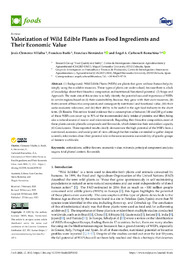Por favor, use este identificador para citar o enlazar este ítem:
https://hdl.handle.net/11000/32370Registro completo de metadatos
| Campo DC | Valor | Lengua/Idioma |
|---|---|---|
| dc.contributor.author | Clemente Villalba, Jesús | - |
| dc.contributor.author | Burló, Francisco | - |
| dc.contributor.author | Hernández, Francisca | - |
| dc.contributor.author | Carbonell-Barrachina, Ángel A. | - |
| dc.contributor.other | Departamentos de la UMH::Producción Vegetal y Microbiología | es_ES |
| dc.date.accessioned | 2024-06-28T10:56:11Z | - |
| dc.date.available | 2024-06-28T10:56:11Z | - |
| dc.date.created | 2023-02-27 | - |
| dc.identifier.citation | Foods 2023, 12(5), 1012 | es_ES |
| dc.identifier.issn | 2304-8158 | - |
| dc.identifier.uri | https://hdl.handle.net/11000/32370 | - |
| dc.description.abstract | (1) Background: Wild Edible Plants (WEPs) are plants that grow without human help, by simply using the available resources. These types of plants are undervalued, because there is a lack of knowledge about their bioactive composition and nutritional/functional potential. (2) Scope and Approach: The main aim of this review is to fully identify the potential uses and importance of WEPs in certain regions based on (i) their sustainability, because they grow with their own resources, (ii) their content of bioactive compounds and consequently nutritional and functional value, (iii) their socio-economic relevance, and (iv) their ability to be useful in the agri-food industry in the short term. (3) Results: This review found evidence that a consumption of between 100 and 200 g of some of these WEPs can cover up to 50% of the recommended daily intake of proteins and fiber, being also a natural source of macro- and micro-minerals. Regarding their bioactive composition, most of these plants contain phenolic compounds and flavonoids, which determine their antioxidant capacity. (4) Conclusions: These reported results clearly demonstrate the high potential of the WEPs from a nutritional, economic and social point of view; although further studies are needed to gather deeper scientific information about their potential role in the socio-economic sustainability of specific groups of farmers worldwide | es_ES |
| dc.format | application/pdf | es_ES |
| dc.format.extent | 21 | es_ES |
| dc.language.iso | eng | es_ES |
| dc.publisher | MDPI | es_ES |
| dc.rights | info:eu-repo/semantics/openAccess | es_ES |
| dc.rights.uri | http://creativecommons.org/licenses/by-nc-nd/4.0/ | * |
| dc.subject | Antioxidants | es_ES |
| dc.subject | Edible flowers | es_ES |
| dc.subject | Economic value | es_ES |
| dc.subject | Minerals | es_ES |
| dc.subject | Principal component analysis | es_ES |
| dc.subject | Sugars | es_ES |
| dc.subject | Total phenol content | es_ES |
| dc.subject | Flavonoids | es_ES |
| dc.subject.other | CDU::6 - Ciencias aplicadas::63 - Agricultura. Silvicultura. Zootecnia. Caza. Pesca | es_ES |
| dc.title | Valorization of Wild Edible Plants as Food Ingredients and Their Economic Value | es_ES |
| dc.type | info:eu-repo/semantics/article | es_ES |
| dc.relation.publisherversion | https://doi.org/10.3390/foods12051012 | es_ES |

Ver/Abrir:
Valorization of Wild Edible Plants as Food Ingredients and Their Economic Value.pdf
683,41 kB
Adobe PDF
Compartir:
 La licencia se describe como: Atribución-NonComercial-NoDerivada 4.0 Internacional.
La licencia se describe como: Atribución-NonComercial-NoDerivada 4.0 Internacional.
.png)